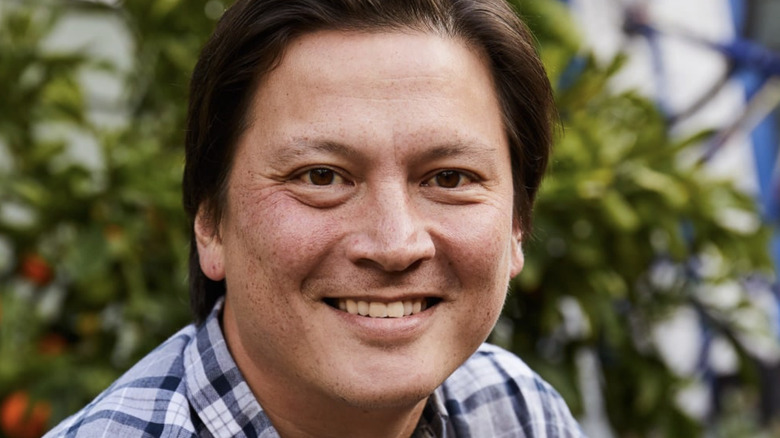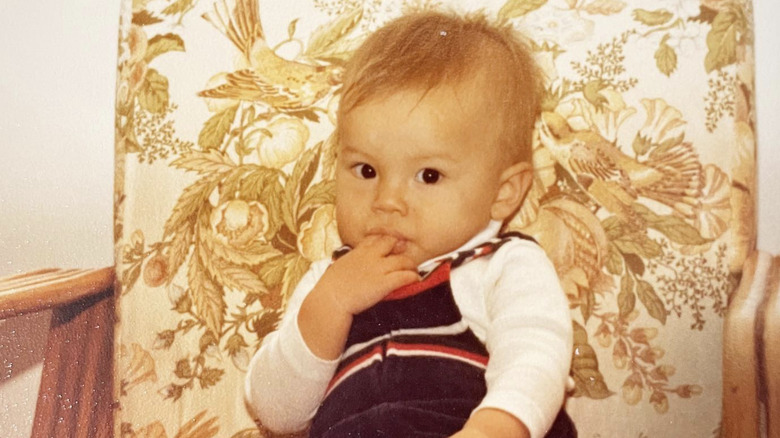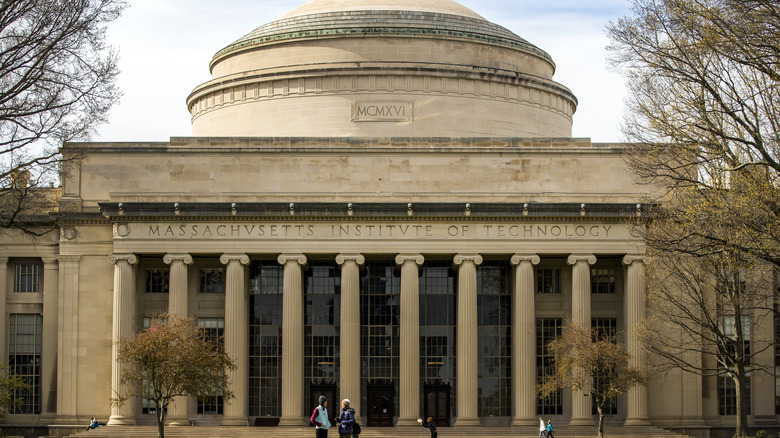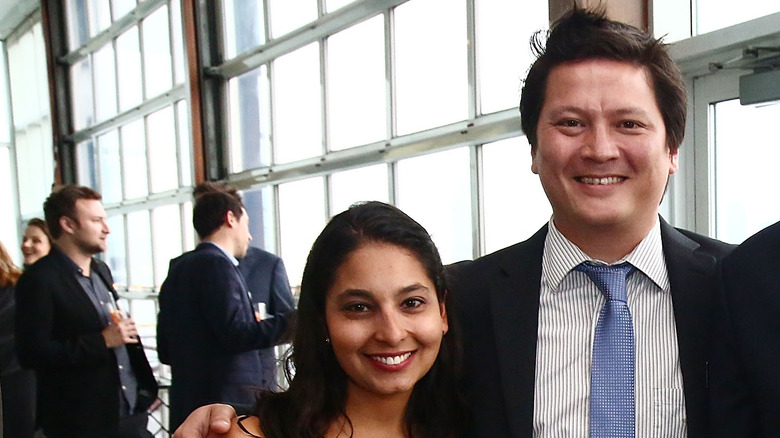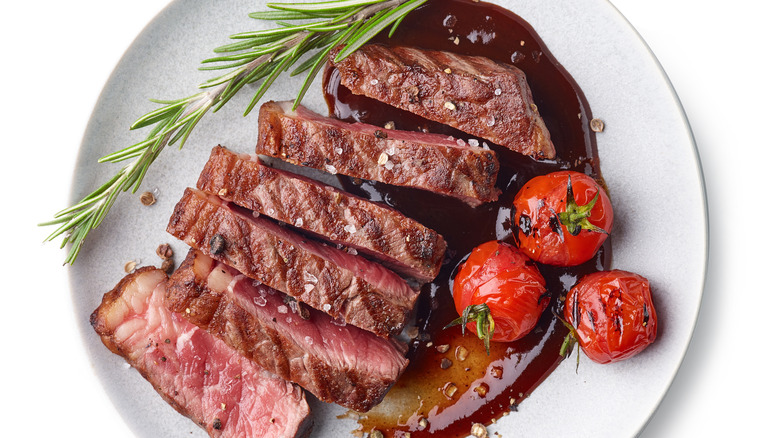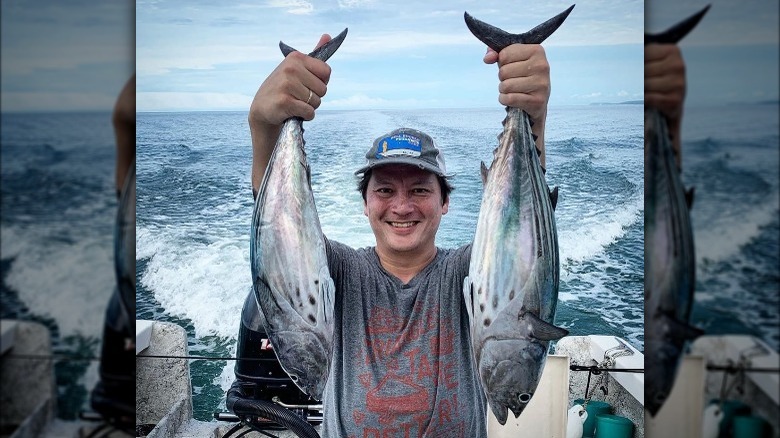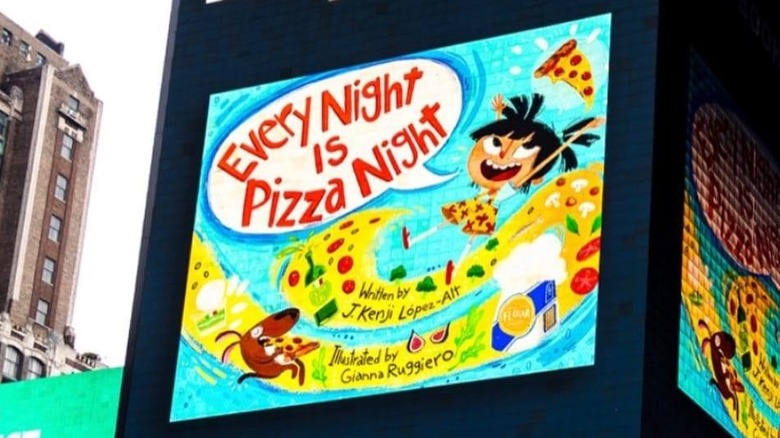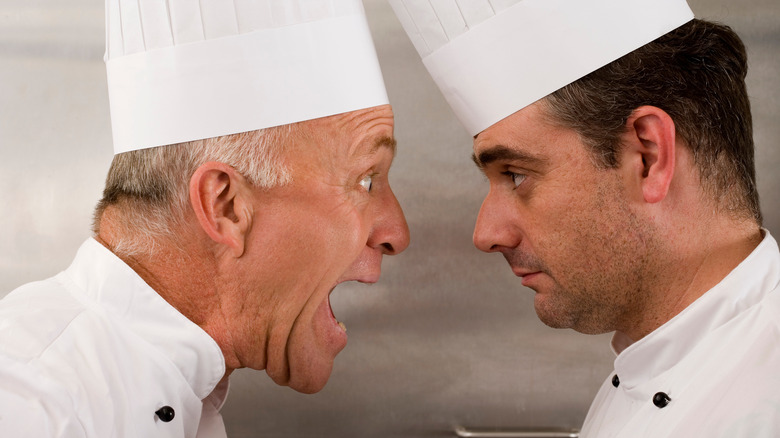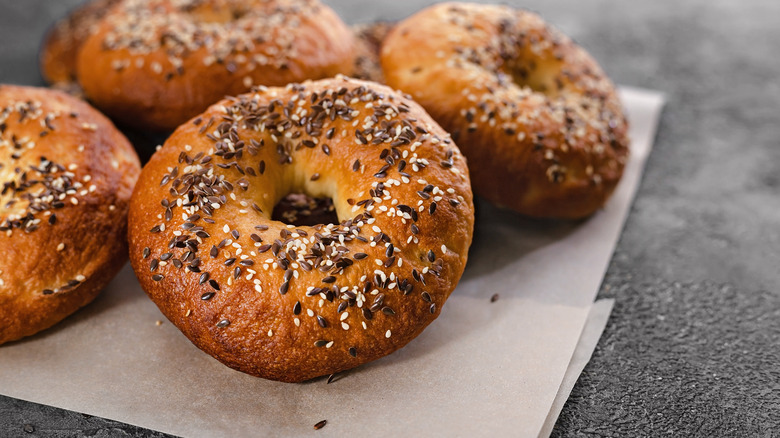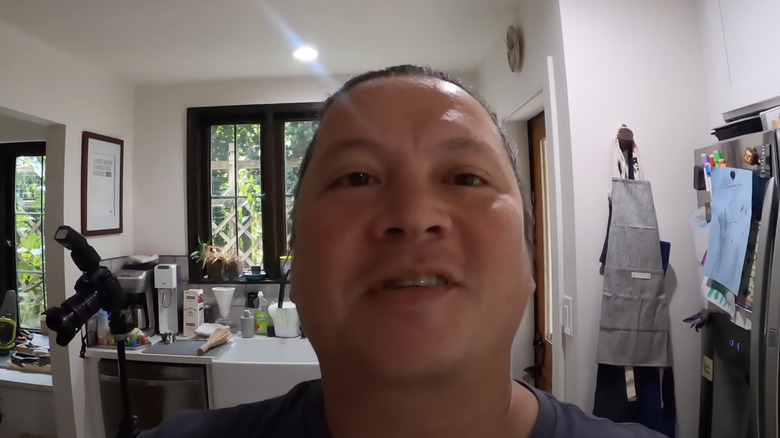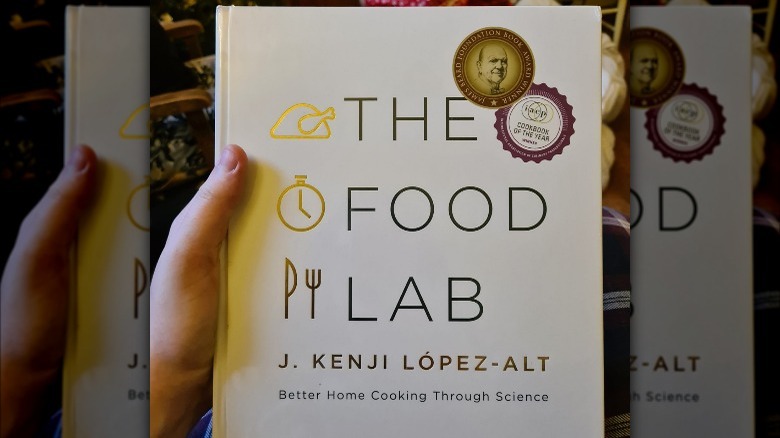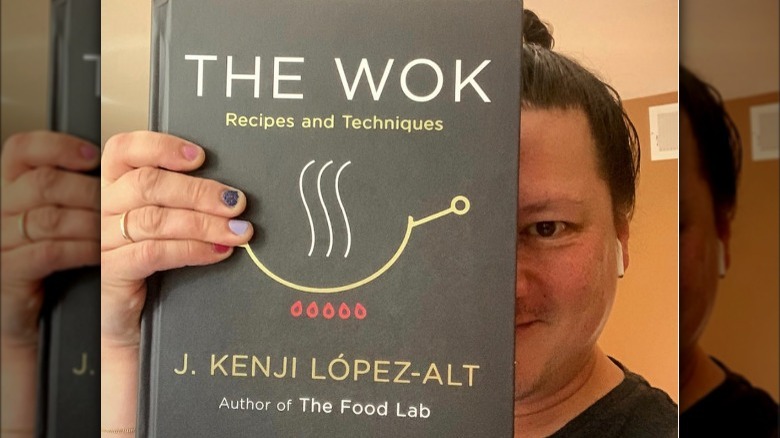The Untold Truth Of J. Kenji López-Alt
Anybody who's interested in the scientific reasons behind why certain cooking techniques work better than others (or who spends a fair amount of time on food YouTube) probably knows who J. Kenji López-Alt is. According to his website, he's a chef, restaurant owner, writer, and video creator. After rising to fame as the culinary director of Serious Eats, he's become a fixture across the food media landscape.
While you might be very familiar with Kenji's persona and recipes, you might not know much about the man behind the curtain. It would be an understatement to say he's had an interesting life. From his childhood surrounded by scientists to his college years at MIT to his experience in prestigious, grueling restaurant kitchens, López-Alt went through quite a journey to reach where he is today. If you're a big López-Alt fan who wants to know more about your favorite culinary superstar, read on to discover his untold truth.
López-Alt was raised by a scientific family
The brainy, scientific cooking persona of J. Kenji López-Alt makes perfect sense, considering he comes from a family of scientists. His dad, Frederick Alt, was a geneticist, and his mom's father chaired the chemistry department at Columbia University (via Seattle Met). He certainly had access to more interesting food than the average American child did when he was growing up, as his father would take him to eat in New York's Chinatown and his Japanese grandmother would cook him traditional dishes.
Despite this, food was not a huge part of his life when he was a kid. He was more preoccupied with hobbies like violin and guitar, and he was quite interested in science. One aspect of his childhood that definitely helped him in his later food career was his insatiable curiosity; he always wanted to know why things were the way they were. He didn't learn how to cook at all before college; as a teenager, he once failed so hard at making pasta sauce that he tossed his noodles with jarred salsa instead.
He had an unconventional path toward becoming a food writer
J. Kenji López-Alt was not destined to become a food writer. As you might be able to glean from his science-focused approach to cooking, he originally dreamed of being a biologist. However, once he started pursuing the field in college, he realized that he despised lab work and wanted to pursue a different career (via The New Yorker). He did eventually earn a diploma, but it wasn't in a field that had anything to do with cooking (at least, not directly). Instead, his degree is in architecture. While he didn't pursue this career long-term, he did find it useful when he was renovating his house in the Bay Area, according to Grub Street.
Per GQ, López-Alt realized his true love was cooking, and he dove into the field head-first by working in some of Boston's finest restaurants. He was able to use his kitchen experience to get a writing job at Cook's Illustrated. Next, he began writing for Serious Eats, which is where he became a food media star. Despite all the success he's had, his mom is still suspicious of his food career. He said to GQ that "She still thinks I made the wrong decision, but that I just got lucky. Which is probably true."
López-Alt is an MIT graduate
Where exactly did J. Kenji López-Alt earn his architecture degree from? It was the Massachusetts Institute of Technology (MIT), which is currently tied for the number two spot on the U.S. News and World Report ranking of the top universities in America.
While he didn't end up using his degree from MIT much in his professional life, his time at the university proved fruitful in other ways. According to Seattle Met, he got his first cooking job during one of his summer breaks (he originally wanted to be a server, but the only job he could get was as a prep cook). Even though he had never really cooked before and was at the bottom of the kitchen hierarchy, the job made him fall in love with food and changed the course of his life.
After he graduated, López-Alt took a job cooking for his college fraternity, a coed literary organization called the Number Six Club (via MIT Technology Review). It was there where he met his future wife (and fellow MIT grad) Adriana López.
His wife, Adriana, works in software
Per Seattle Met, Adriana López (now López-Alt) grew up in Bogotá, Colombia. (López-Alt is a hyphenation of her last name and Kenji's original last name, Alt.) She took a much different professional path after graduating from MIT than her husband did, eventually earning a Ph.D. from New York University. According to MIT Technology Review, her Ph.D. is in cryptography. Kenji followed her to New York when she was attending NYU, then moved with her again to the Bay Area, and then, finally, to Seattle.
She appears to excel in her field if her Linkedin page is anything to go by. She worked at Google, which according to Inc. accepts a lower percentage of applicants than Harvard. Now she's a principal security engineer at Square. In 2015, NYU invited her back to speak to current Ph.D. students about her time as a grad student and her experience working for Google (via NYU WinC).
He invented the reverse-sear method for cooking steak
Reverse-seared steak is such a commonly-recommended method these days that it might surprise you to find out how recently it was invented. This technique, which some argue is the best way to cook a steak, was dreamed up by J. Kenji López-Alt in 2007 while he was working for Cook's Illustrated (via The New Yorker).
A reverse sear turns the traditional method of cooking a steak on its head. Rather than starting with a ripping-hot pan and then finishing with a trip to the oven if necessary to finish cooking, reverse-searing starts by bringing the steak up to temperature in a low oven and then adding the crust in a hot skillet right at the end. In addition to giving you a perfect, tender interior, this method also enhances the level of browning you get on the outside, according to The Washington Post.
In the interest of fairness, we should mention that a few other cooks had been experimenting with similar techniques around the same time that López-Alt was. However, he wrote about it first and coined the name, so he gets the glory.
López-Alt works two days a week
In the early phase of his career, J. Kenji López-Alt had an unbelievably intense work schedule. He told GQ that when he worked at Serious Eats, "I would go to the office at 10 a.m., leave at 8 p.m., write more at home until midnight, and then work on my book from midnight until 4 a.m." This work ethic helped him create the following he has now, but he realizes in retrospect that the all-consuming focus on work wasn't healthy for him, his family, or his coworkers.
These days, the chef's life is almost the polar opposite of his Serious Eats-era grind — he works about two days a week. That's not to say that he isn't staying busy. He is a stay-at-home dad with two small children and spends much of his time hanging out with his kids. His relaxed work schedule also allows him to explore his hobbies, of which he has many, including music, woodworking, and checking out the restaurants in his new home base, Seattle. It sounds like a pretty enviable existence to us.
He wrote a children's book
Most of J. Kenji López-Alt's food writing skews wonky and science-based. It's not exactly the kind of stuff that you would imagine being entertaining for a small child. However, the chef decided to step out of his comfort zone and write a children's book, "Every Night is Pizza Night," which was published in 2020 (via Serious Eats).
The book interrogates the idea of what counts as the "best" food. The main character thinks that pizza is the greatest food ever, but she meets other children from different cultural backgrounds who tell her that their favorite foods are actually the best.
It's a simple premise, but López-Alt discovered that writing a children's book was much less simple than he originally thought it would be. For one, he had to figure out how to modify his trademark verbose style into something kids would like; the 1,000-word book started out 10 times longer. He also found collaborating with an illustrator to be both challenging and rewarding.
López-Alt disavows 'bro' cooking culture
GQ reports that well over three-quarters of J. Kenji López-Alt's subscribers on YouTube are male. The New Yorker also remarks on how many of his acolytes are men who relish the nerdy, fact-based approach he takes to creating content.
This aspect of Kenji's fanbase is not something he's entirely comfortable with. He told GQ that his first book "The Food Lab," "got picked up by this sort of bro cook culture that tends to put people down. People weaponize knowledge in negative ways — which wasn't my intention, but probably a thing I also used to do."
In more recent times, the chef has decided that it's best to focus on treating other people kindly and being less rigid about his opinions. In his interview with The New Yorker, he says that he picked up an aggressive demeanor from his time working in fine-dining restaurant kitchens that sometimes made him unkind to his coworkers, friends, and family, especially during his Serious Eats tenure. He regrets how he acted back then, and now focuses on being a positive role model for his children.
He has become something of a Seattle food influencer
When J. Kenji López-Alt moved from the Bay Area to Seattle, he immediately started looking for Seattle's best bagels. While he was initially disappointed with the options in his new home (as a native New Yorker, he has high standards for bagels), he eventually found some options that he claims can compete with the best that New York has to offer (via The Seattle Times).
When López-Alt finds food that he enjoys, he often shares his meal on Instagram. And when he does, it often results in a dramatic increase in sales for the restaurants he visits. When he posted that he enjoyed Rachel's Bagels & Burritos, the business started running out of bagels by mid-morning every single day, according to Seattle Reports.
Although Kenji's power over the fortunes of the food businesses he likes makes him an undeniably powerful food influencer, he's uncomfortable with that role. In fact, he denies he's an influencer at all, telling Seattle Reports, "I wouldn't call myself that." However, if he keeps on posting his meals on Instagram, he's going to continue generating sales for grateful Seattle restaurant owners, no matter what label he uses to describe himself.
'Kenji's Cooking Show' started out as a hobby
By any measure, J. Kenji López-Alt's Youtube show, which is simply titled "Kenji's Cooking Show," is incredibly successful. As GQ notes, the chef's YouTube channel has more subscribers than The New York Times cooking channel even though he only started regularly uploading videos in April 2020. He doesn't go out of his way to produce content on a schedule or carefully plan his videos; in fact, he only shoots episodes when he's already cooking something for his family.
Although he still thinks of his YouTube career in casual terms, it rakes in serious money: around $200,000 a year, despite the fact that he doesn't create any sponsored content. He told The New Yorker that the channel is currently his main source of income.
The show's style is distinctive. It's almost entirely shot with a GoPro mounted on Kenji's head, which means you almost never see the chef on camera. The inspiration for this format comes from an unlikely source: "Hardcore Henry," the action movie that was shot entirely in first-person.
'The Food Lab' combined science with home cooking
J. Kenji López-Alt's original column at Serious Eats was called The Food Lab. In it, he explored common home-cooking questions through a scientific lens, often using elaborate experiments to answer seemingly-simple culinary quandaries (he ended up cooking over a hundred eggs for his first column, which tried to find the perfect way to boil an egg, per Serious Eats).
Eventually, he turned the column into a book of the same name. "The Food Lab" was a massive doorstopper, coming in at just under 1,000 pages. Wired praised how the book combined the scientific food techniques of food writers like Harold McGee and books like "Modernist Cuisine" with simple advice that was accessible to a home cook. The New Yorker review of the book noted that despite all the science in the book, it had simple recipes and didn't require ingredients you'd have to order from a chemical supply store. The mixture of science and solid technique made the book a huge success, and it has sold over 500,000 copies since it was released, according to López-Alt's website.
He is a wok master
J. Kenji López-Alt's most recent book, entitled "The Wok," is devoted to this uniquely versatile cooking tool. He's been using the same wok for over two decades, and he says it's the pan he turns to the most (via Vogue). His book is filled with recipes and techniques that help even wok novices get the most out of this under-appreciated pan.
While most people think of woks as being stir-frying pans (and they are indeed perfect for that), they can be used for myriad other applications. One of López-Alt's favorite ways to use his wok is for deep-frying, which he says he doesn't do in any other vessel. As opposed to something more traditional like a pot or a Dutch oven, woks are great for deep-frying because the wide, flared sides catch oil splatters and guard against dangerous boil-overs. Also, the wide opening of a wok makes it easier to manipulate food while it's frying.
López-Alt also busts the myth that you can only use a wok if you have an intensely-hot gas stove. He tells WBUR that even on an electric burner, you can get great results when stir-frying with a wok.
